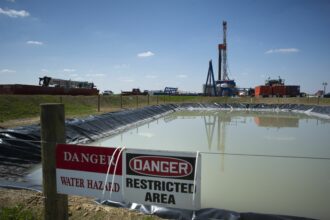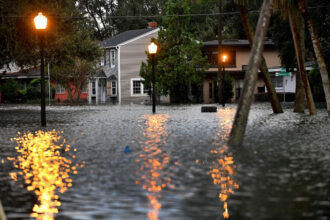Pennsylvania would run its own cap-and-invest program for cutting carbon emissions from power plants and increase its use of renewable fuels if lawmakers approve two bills outlined by Gov. Josh Shapiro on Wednesday.
The proposal to set carbon caps for about 55 power plants could replace the state’s participation in the Regional Greenhouse Gas Initiative, a cap-and-invest cooperative under which 11 Eastern states cap emissions from their power sectors and require power generators to buy “allowances” at periodic auctions for each ton of carbon they will emit above the cap. Member states use the proceeds to invest in clean energy.
Pennsylvania’s plan to join the group, begun by the previous Democratic governor, Tom Wolf, has been mired in court challenges from state Republicans. Last November, Wolf’s plan was overturned by an appeals court which ruled that joining RGGI would result in the administration unconstitutionally imposing a tax on electric consumers.
The Shapiro administration has appealed the ruling to the state Supreme Court, but the first-term Democratic governor said on Wednesday he will drop the appeal if the Legislature approves the two bills.
“If the Legislature passes my plan … I will sign it and immediately remove the Commonwealth of Pennsylvania from RGGI,” Shapiro said in a speech at a union hall in Scranton.
The Pennsylvania Climate Emissions Reduction Act (PACER) would direct the Department of Environmental Protection to set a cap for the amount of carbon that large power plants can emit, then require them to buy credits to offset any carbon emissions above the cap. The level of the cap and the price of the credits will be contained in a bill due to be introduced in coming days, Shapiro said.
As the biggest exporter of electricity among U.S. states, Pennsylvania should be able to set its own standards for curbing power plant emissions, rather than complying with the RGGI rules, which are set regionally, he said.
“We will not take direction from anyone outside of this Commonwealth,” Shapiro said. “We will set our own cap and we will set our own price for those carbon credits. We won’t have any other state determining what is right for us in Pennsylvania.”
Seventy percent of the PACER revenue would be directed back to Pennsylvania residents so that none would pay higher electricity bills, and some would pay less, Shapiro said. Some of the rest would be invested in clean-energy projects such as carbon capture and storage and clean hydrogen in communities that have historically hosted the oil, coal or natural gas industries.
“PACER allows Pennsylvania to chart its own energy future, independent from the influence of both foreign oil and other states’ energy policies,” the administration said in a press release.
Shapiro announced another bill that would require the state to get 50 percent of its electricity from an increasing variety of renewable sources by 2035, and would add wind, solar and nuclear power produced from small modular reactors to the total. The Pennsylvania Reliable Energy Sustainability Standard (PRESS) would replace the current Alternative Energy Portfolio Standard.
Together, the two bills would create some 14,500 energy jobs and save ratepayers $252 million in utility bills over five years, Shapiro said.
Although Pennsylvania was an early adopter of alternative energy standards, it has made no changes to that for 17 years, and now ranks 45th in the U.S. for investing in clean-energy sources like wind, solar and hydropower, Shapiro said.
The PRESS bill is designed to incentivize more reliable power generation in the face of threats, including extreme weather and cyber attacks.
Initial reaction to Shapiro’s plans from Republican lawmakers—who control the state Senate—suggested that the bills’ future is far from assured in the Legislature.
“For over a year, Senate Republicans have urged Governor Shapiro to set aside the disastrous Regional Greenhouse Gas Initiative (RGGI) and pursue an energy strategy that puts Pennsylvania families and job-creators first and ensures we have a safe, reliable electricity grid,” said Sen. Scott Martin (R, Lancaster), chairman of the Senate Appropriations Committee, in a statement. “It is difficult to move forward on Pennsylvania energy decisions when the governor is continuing to fight us in court to enact a policy that takes away jobs and pushes energy prices even higher.”
Martin and other Republicans urged Shapiro to withdraw his appeal to the state Supreme Court in order for Republicans to “negotiate in good faith” over the planned bills.
Sen. Kim Ward of Westmoreland County, the Senate President Pro Tempore, said Pennsylvania should be doing more to develop its energy resources, not taxing them as she said Shapiro’s plan would do.
The proposals seem to have more in common with California and Washington state that suffer from rolling blackouts and higher energy prices, the Republican Senate leader said.
The new plans are the result of a working group of labor leaders, environmentalists and industry executives, brought together by Shapiro to consider whether joining RGGI was the best way for the state to cut carbon emissions from power plants.
Among supporters of Shapiro’s plan who spoke at the Scranton event was Robert Bair, president of the Pennsylvania Building & Construction Trades Council, who urged lawmakers to approve the bills.
“When the governor told you, ‘We can’t afford to do nothing,’ he’s 100 percent correct,” Bair said. “For the last five years, we haven’t moved the needle. We haven’t created jobs. We’ve been sitting still. That’s not an option.”
The participation of figures like Bair shows there’s now backing among the trade union community for the plan, while they had been under pressure to reject RGGI membership, said David Hess, a former environment secretary who now edits an environmental newsletter.
“I think what the governor has done is given House Democrats some running room on these issues because they were feeling lots of heat from the Construction Trades and other unions to simply reject RGGI,” Hess said.
The working group agreed in September last year that cutting greenhouse gas emissions in Pennsylvania is both necessary and inevitable, and that a cap-and-invest program was the best way to do that. But they didn’t reach consensus on whether the cap-and-invest system would work best in the RGGI region or across the 13-state area covered by PJM Interconnection, the nation’s largest power grid, covering much of the northeast and mid-Atlantic, plus some midwestern states.
The working group included David Masur, executive director of the nonprofit PennEnvironment, who defended Shapiro’s continuing appeal to the Supreme Court over RGGI membership but said he’s also open to other ways of curbing carbon emissions from the power sector.
“We don’t think having more irons in the fire is a bad thing, especially since we have no idea how long the court case will go, and to have a backup plan in case the courts come down on the wrong side of the RGGI case,” Masur said.
This story is funded by readers like you.
Our nonprofit newsroom provides award-winning climate coverage free of charge and advertising. We rely on donations from readers like you to keep going. Please donate now to support our work.
Donate NowHe argued that the Governor’s plan is designed to signal to the Senate that he is serious about tackling climate change, and has options for achieving that, but only “if the Senate is willing to actually have a pro-active conversation about steps forward.”
The current RGGI states say they have cut their carbon emissions faster than non-members since they began cooperating in 2009. But whether Pennsylvania would see a comparable rate of emissions reduction won’t be known until the bills become available, analysts said.
Rob Altenburg, senior director for energy and climate at the nonprofit PennFuture, predicted it will be an uphill battle for Shapiro to win approval, especially in the Senate, because “It’s hard to get anything passed in Pennsylvania”—which has the nation’s only divided state legislature.
But he said the plan offers an opportunity for the foes of RGGI membership to craft legislation that would achieve the same thing without complying with the regional rules. “For the legislative opponents of RGGI, this clearly is an opportunity to draft something that they like better,” he said.
Pennsylvania’s powerful fracking industry—the state is second in natural gas production, trailing only Texas—is strongly opposed to RGGI membership and can be expected to oppose Shapiro’s own cap-and-invest plan, which would also impose costs on natural gas power plants and help fund renewable energy.










